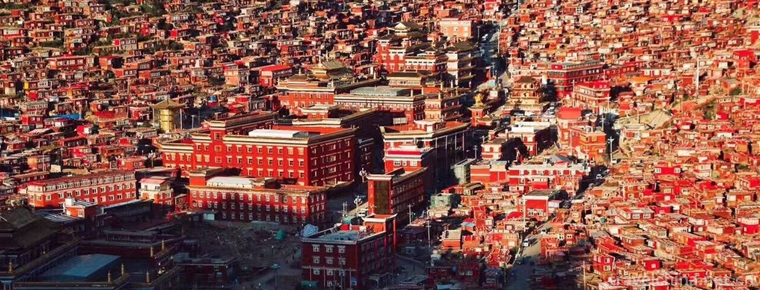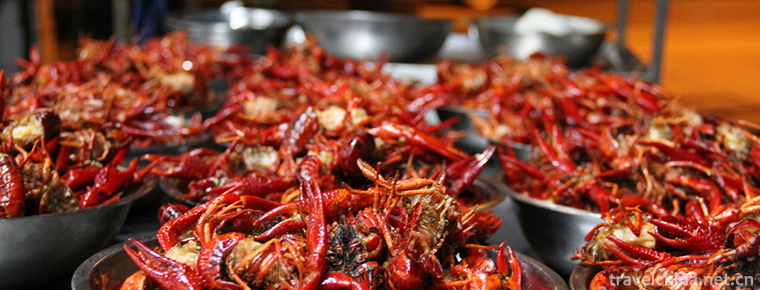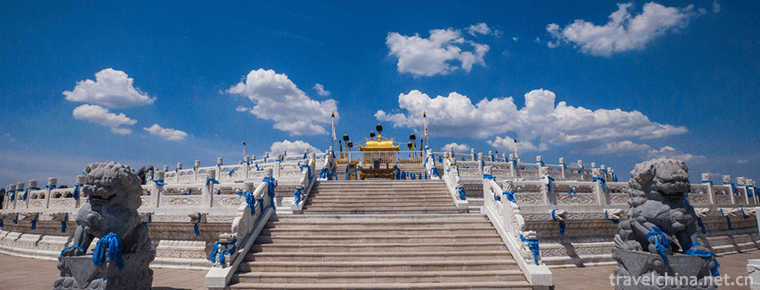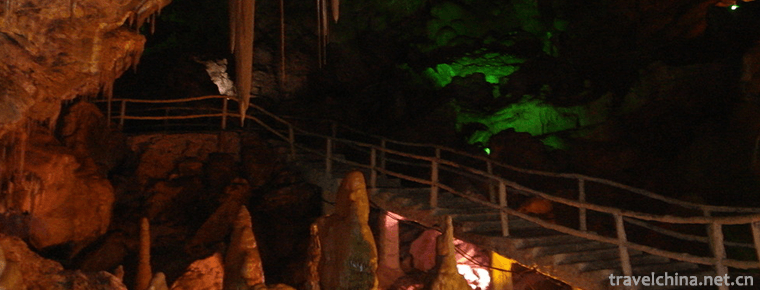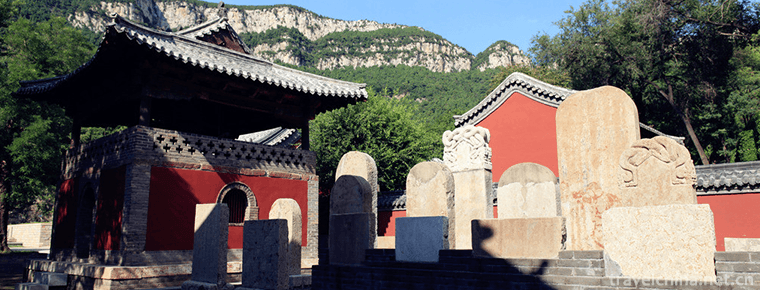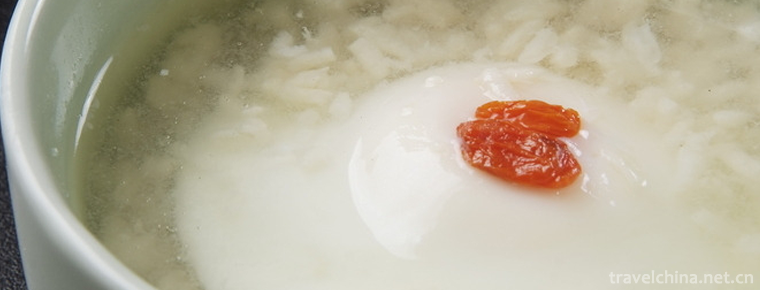Guanmenshan National Forest Park
Guanmenshan National Forest Park is located 70 kilometers southeast of Benxi City. The Forest Park covers an area of 3517 hectares, with an altitude of 310-1234 meters and a forest coverage rate of 85%. The plants in the garden are well preserved, with numerous ancient and famous trees and beautiful scenery. It is a forest tourist attraction that integrates tourism, sightseeing, shelter, vacation and leisure. It is also one of the 50 best sceneries in Liaoning Province. There are four scenic spots in the forest park, Xiaohuangshan scenic spot, Jialazi scenic spot, Longmenxia scenic spot and platform scenic spot, totaling 108 scenic spots. Since its establishment and opening up in 1998, it has received 6 million tourists.
geographical environment
Located in the south of Benxi County, Liaoning Province, Guanmen Mountain has been known as "Huangshan Mountain in Northeast China" and "Guilin in Northeast China" since ancient times. Because of the confrontation of two peaks, one broad and one narrow, one big and one small, its shape is like a door, so it is called Guanmen Mountain. Guanmen Mountain is known as "Xiaohuangshan in Northeast China". It has five beautiful sceneries: beautiful mountains, strange peaks, rising from the ground, graceful peaks, strange rocks, like a giant bonsai built by heaven and earth. Shuimei, Guanmenshan Reservoir ripples, two cliffs reflect the green mountains, paddling and boating, its joy is endless. Shumei, Shumen Mountain is famous for its beautiful autumn maple forest. Beautiful flowers, Magnolia and Rhododendron, all over the mountains, fragrant and pleasant. Cloud beauty, cloud, mountain, beauty and fog are all in one, especially charming. In recent years, the light fog is dazzling and confusing. Clouds are steaming in the distance, and the weaving of clouds is clever. The peaks are faint and charming and shy.
Guanmen Mountain is famous for its maple leaves. There are too many maple leaves to count. The beauty makes you feel like you are in a fairyland. The red is like a big flame. The maple leaves here are attached to one another, one to another, like a flame, like a fan, in thousands of shapes and various forms. The maple leaves of Guanmen Mountain are not only beautiful, but also magnificent, and the water is so clear. The waters of Guanmen Mountain are colorful, sandwiched between the two mountains, and there is a colorful pond. There are many colorful maple leaves in the pool. After sunshine, the pool reflects various colors, adding many colors to the pool, making the pool more gorgeous, just like fairyland on earth, very beautiful.
The four seasons in the scenic area have their own characteristics. Spring, mountains and flowers, colorful; summer, cypress verdant trees, cool; autumn, bright red, golden yellow, wild fruit fragrance; winter, snow welcome guests, ice cliffs hundred Zhang. A Comprehensive Tourism Development Zone integrating food, housing, transportation, tourism, shopping and entertainment has been formed.
Layout of scenic spots
Located 13 kilometers south of Benxi Water Tunnel, Guanmen Mountain has three gates: North gate, in the direction of the small city, two peaks confront each other, and the middle arch bridge is connected; South gate, at the top of the Tanggou Ridge, passes through the highway, which is very dangerous; in the middle gate, in the deep valley channel, Shuangyi Jiashui, which is only 20 meters wide, is the natural gate pillar of Xingxiu Reservoir. Some people call Guanmen Mountain scenery "Xiaojiangnan". "Saihuang Mountain", said it has five beautiful: beautiful mountains, steep, handsome, like a cluster of bonsai; beautiful trees, a wide variety of trees, especially the maple leaves in autumn, winter rooted in the cliffs of the pine, very spectacular; beautiful water, Tanghe through valleys, convergence streams, waterfalls, "snatching doors" and out, as if from the horizon; beautiful flowers, Tiannu Mulan, mountain azaleas, all over the mountains; beautiful clouds; After the rain in the morning, the clouds in the valley are very charming, like veils. Many literati in the past dynasties have praised poems. Many artists often come here to sketch and paint.
natural resources
Maples are summer green trees or shrubs. Leaves palm-shaped, opposite. The leaves of a maple leaf are pinnate. There are monoecious and dioecious maple species. Some species are insect-borne, others are wind-borne. Flowers have five petals and stamens partly degenerate. Ovary superior. There is a disc-shaped structure at the bottom of the flower, which is used to attract insects in non-wind-borne species. Guanmen Mountain is a famous maple-dominated national tourist attraction in China. There are more than 120 kinds of maple trees in the scenic area. The more famous ones are Japanese red maple, Chinese red maple, pentagonal maple, triangular maple, feather maple, green maple, Yuanbao maple, blood maple, chicken paw maple, Kam maple, beautiful maple, red winged maple, camphor leaf maple and so on. In autumn, the maple leaves all over the mountains make up the whole day.
In addition, there are many precious animals in the scenic area. There are more than 50 kinds of animals under the second-level protection of the state only, such as stone mink, yellow-throated mink, otter, Small-clawed otter, spotted forest cat, big cat, big cat, small cat, grassland class cat, desert cat, jungle cat, wadeer, deer, deer, deer deer, deer deer deer deer, eldeer, yellow deer, yellow sheep, eel eel, eel, mink, amputfish, catcatcatcatA. North arrowhead, Chinese wingless insect, black wingless insect and so on. It can be a treasure house for animals.
Characteristics of scenic spots
Guanmenshan Forest Park covers an area of 3,517 hectares with 95% forest coverage. It has well-preserved vegetation, numerous ancient trees and famous trees, and beautiful scenery. It is a forest tourism scenic spot integrating tourism, sightseeing, summer resort and leisure. It is also one of the 50 best scenic spots in Liaoning Province. It was rated as national AAAA scenic spot in 2001 and National AAA scenic spot in 2015.
There are four scenic spots in the forest park: Xiaohuangshan scenic spot, Jialazi scenic spot, Longmenxia scenic spot and platform scenic spot, totaling 108 scenic spots. Every scenic spot or beautiful mountains, or canyons, or streams lingering, or shade, walking and changing scenery, have a lot of imagination. Among the scenic spots, the "Lion Guard" in Jialazi Scenic Area and the "Crystal Curtain Falls" in Longmenxia Scenic Area are the most spectacular. "Lion guard" mountain cliff, quite like a lion, angry eyes, guard the pass. "Crystal Curtain Waterfall" is like snow waves, three folds and falls, splashes of water at the break, pours into the Qingtan Lake, and booms and rings. In particular, the first exhibition of the Kunming World Expo in Benxi City, Mulan, has become the most unique landscape in Guanmenshan National Forest Park.
The four seasons in the garden have their own characteristics. In spring, mountains and flowers are colorful; in summer, cypress trees are green and cool; in autumn, they are red, golden and yellow, and wild fruits are fragrant; in winter, snow welcomes visitors and ice cliffs are hundred feet long.
There are five beauties in Guanmen Mountain: beautiful mountains, beautiful waters, beautiful trees, beautiful flowers and beautiful fog. After the morning and evening rains, clouds and mists rise, momentum is great, clouds and feet move slowly, green mountains brush their veils, peaks appear when hidden, just like Yao Chi fairyland and nine cave heavens.
Walking in the scenic area, you can hear the birds chirping everywhere; you can see butterflies flying everywhere; occasionally you can see rabbits, roe-deer and so on, jumping from the forest, wild fun, the second-class national protection animal mandarin ducks play on the water, black bears also often appear.
When you wander in the poetic space picture of Guanmenshan National Forest Park, you will have infinite joy from the bottom of your heart. That comfort, that comfort, can only be meaningless. It is:
The scenery of Guanshan is very beautiful.
Fatigue-relieving, fatigue-relieving and delicious resort service.
Main attractions
edit
Xiaohuangshan Scenic Area
Xiaohuangshan Scenic Area is famous for its danger in Guanmen Mountain. Its momentum is magnificent, which is the true epitome of Huangshan Mountain in Anhui embedded in Guanmen Mountain.
Platform Scenic Spot
Tall trees, mainly pine trees. In late autumn, all the leaves are yellow. Thick pine needles lay on the ground and were very soft to walk on. More noteworthy is the strong flavor of pine wood, let people aftertaste.
Longmen Gorge Scenic Area
Maple trees are the main scenic spots, maple leaves began to increase, and the famous Maple king is also here. In late autumn, the whole mountain seems to be burning like a fire, a red and gorgeous scenery, let people linger back and forth.
Telaga Wama
Every autumn when the mountains are red, the forests on the lakeside mountains are colorful, and the reflections form colorful colors in the lake water. Therefore, the lake is named "colorful lake", which is a special autumn scene of Guanmen Mountain.
Lion guarding
Mountains and rocks, quite like a lion, open-eyed, guarding the pass.
Tourism information
Traffic information
By train: Beijing-Dandong Line passes Benxi along the way; Shenyang North-Dandong Line passes Benxi. After arrival, take a 7 Yuan passenger or bus to the small city passenger station. Passengers who arrive at the station and then transfer to Caohekou are at the foot of Guanmen Mountain for 3 yuan each. You can also take a bus directly to Guanmen Mountain from the passenger terminal to Guanmen Mountain (6-8 tourists are recommended). Business can be done at 20 yuan per car, which is comfortable and fast. Passengers in Shenyang can also take buses. The station is at the intersection across the street from the ticket office of Shenyang Railway Station. The fare is 15 yuan per person once every 15 minutes. After arriving at the station, we still take a 7 yuan minibus or bus to the small city passenger station.
Accommodation: Standard rooms in scenic spots range from 120 to 180 yuan per day. They can also be charged at 25 to 30 yuan per bed. Reservation of hotel rooms in advance can guarantee both check-in and 8-9% discount. It is recommended to stay in "cottage courtyards" with farming characteristics. Not only can you live in the fire, feel the pure farm life, but also save half the price, which is quite cost-effective! About 20 yuan per person.
Best travel time: Benxi belongs to the humid climate zone in the middle temperate zone. Its climate is characterized by beautiful spring wind and sunshine, slightly hot and rainy summer, high air in autumn and snow in winter. The scenic spot is mainly maple, so the best time to watch is autumn.
Local cuisine
Hot pot: Eat "hot pot". This is a popular Manchu dish in Benxi area. Apart from the primitive Dayan hot pot, there are all kinds of modern hot pot. Whichever kind of hot pot is, it is a portrayal of Manchu's life characteristics. Sauerkraut and tofu, the Manchu people are firmly in the north, especially in Benxi area, in the Changbaishan Mountains, where the climate is cold, and they can not eat green vegetables for nearly half a year (this is a past thing). At that time, the people could only eat green vegetables in spring, summer and autumn, so they could only use pots to fry and blanch Chinese cabbage and then submerge them in clay pots for winter and spring consumption. 。 This kind of waterlogged cabbage is called pickle. This dish can be cooked and eaten, as well as dumplings and steamed buns. Nowadays, people have regarded eating pickles as a kind of fresh food. This eating method has become the habits of Manchu people, and has continued to this day. Eating small tofu is the tradition of Benxi Manchu people. According to legend, salt and brine (used for tofu) are scarce and expensive in the areas where Manchu ancestors lived. It is not necessary to add brine to make small tofu, so it is often used for this kind of food. Now there is no shortage of brine, but this dish has always been a favorite food.
Eating "big oil" (lard) is a characteristic of the Manchu people's cooking oil. According to historical records, soybean is the main oil crop in Northeast China, but in the past because of the equipment and technology of crushing oil. The restrictions of workshop production and other conditions are not as convenient as killing pigs and eating big oil. Over time, the habit of eating big oil has become a feature of Manchu people's life.
About the dietary customs and characteristics of the Manchu people in Benxi area, some books in the early Republic of China reflected more specifically and appropriately: "North-South Kang, high table; yellow rice dried rice, big oil sausage; elbow kicking, cut pieces on the end; four dishes, eat blood sausage first". In rural folk songs, "sticky cake, millet porridge, sour vegetable noodles stewed pork, small tofu, pickled vegetables in the ordinary season." Keloids mixed with sauce". Drinking, which is also the preference of the Manchu people, has two main kinds of liquor: barbecue and yellow rice wine. Wine-making, that is, liquor made from corn, sorghum and other grains, has a relatively high degree in general. Yellow rice wine is mainly made from yellow rice (sticky rice) millet. In autumn, every household is also used to making fruit wine, such as mountain wine, jujube (kiwifruit) wine and hawthorn wine.
Long and wide pig hoof: series of products are formulated by the secret recipe of the ancestors, carefully selected and meticulously processed. The main products are: pig hoof, pork tripe, pig elbow, beef, rabbit, chicken neck and other smoked products. The main product is Yan Dong, a unique flavor, with salty flavor, sweet crisp and tender bone, soft and palatable, winter air depression, and four flavors, which are suitable for both young and old.
Sun Changkuan, a national first-class chef and manager of Longsheng Hotel in Benxi, won the first prize in Liaoning Province Local Flavor Food Competition.
This series of food uses more than 20 kinds of precious Chinese herbal medicine in the old forest of Changbai Mountain as condiment. It has the functions of invigorating the spleen and stomach, invigorating qi and nourishing blood, enriching kidney essence, and smoothing the skin. It's a delicacy you give to relatives and friends and on the dining table.
This product is colorless, preservative-free and additive-free.
Sour soup soup: Manchu ancestors lived between Baishan and Heishui, and for a long time took agriculture, forestry, fishing and hunting as their industries. Their productivity was very low, so they had a significant impact on the formation of Manchu dietary habits. Up to now, the Manchu people in Benxi still need to retain relatively complete dietary habits.
Among the Manchu people's lives, the most favorite staple food is millet, which is usually sticky rice, such as millet (rice), sticky rice (millet), barnyard grass, millet (millet), etc. Among them, sticky foods such as yellow rice and millet are especially popular. Such as clay cakes, fried cakes, sticky cakes, sticky bean buns, bean noodles folders, sushi cakes, cattle tongue cakes, Wandang cakes, pineapple leaf cakes, cakes and so on. This is the most traditional food of Manchu people.
Fried noodles and fried rice are also the traditional food of Manchu people in Benxi area. Fried noodles and fried rice are both convenient snacks for Manchus working and children.
Sour soup, which is also the traditional flavor food of the Manchu people, rose from Benxi area, extended to Kuandian, Xinbin, Tonghua, and the staple food of Changbai Mountain area. Later, not only Manchu people liked it, but also Han people and other nationalities ate it.
In the non-staple food consumed by Manchus, pork is the main food, and beef and wild animals are eaten at the same time. Other livestock are generally not killed or killed. When killing pigs, the most important thing is to eat blood intestines, so a popular saying is "busy or not, eat blood intestines". When eating pork, instead of stir-frying, it is cooked meat in a big pot. Putting vegetables in a big pot means cutting some pickles and sitting around with a basin or bowl full. The so-called elbow flower is still the traditional practice. As for the later picking elbow, braised elbow and so on are all from modern chefs.















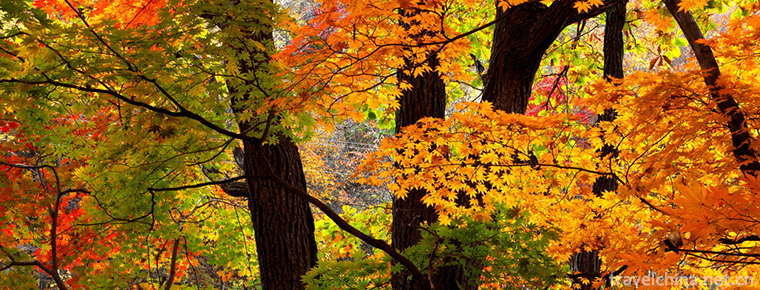
-
Sertar County
Sertar County is a county under the jurisdiction of Ganzi ....
Views: 218 Time 2018-10-12 -
taste shrimp
Taste shrimp, also known as spicy crayfish, Changsha taste shrimp, spicy crayfish and so on, is a well-known traditional snack in Hunan Province.
Views: 206 Time 2018-11-14 -
Genghis khan mausoleum tourist area
Genghis khan mausoleum tourist area, also known as Chengling Tourist Area, commonly known as the Eastern Union Scenic Area (not Genghis Khanling).
Views: 331 Time 2018-12-01 -
Wanxiang Karst Cave
Vientiane Cave, the national AAAA-level tourist attractions, provincial geological parks, provincial scenic spots and provincial cultural relics protection units.
Views: 124 Time 2018-12-17 -
Lingyan Temple in Jinan
Lingyan Temple, built in the Eastern Jin Dynasty, has a history of more than 1600 years. Located in the north foot of Mount Tai in the southwest of Jinan City, Shandong Province.
Views: 246 Time 2019-02-03 -
Fouriers Magic
Fu Tenglong, a national first-class actor and famous magic performer, is a member of the art team in the 1950s. Fu Tenglong was born in a magic family. He is an international magician who integrates p.
Views: 342 Time 2019-05-04 -
The Story of the Hundred Birds Clothes of the Zhuang Nationality
At the beginning of liberation, Guangxi was a remote part of China at that time, but the appearance of Hundred Birds'Clothes showed that Guangxi was not a barren place for literature, and the minority.
Views: 202 Time 2019-08-16 -
Sugar Eggs
Laozao is a local snack, belonging to Sichuan cuisine. Laolao, a kind of wine brewing in ancient Chinese, is a Sichuan dialect, that is, boiled eggs with wine brewing. Put the mash in the pot and boil.
Views: 468 Time 2020-03-09 -
Furong mountain
Furong mountain in Sichuan Province is a snow mountain, stretching for hundreds of miles. Furong mountain scenic area is composed of Furong mountain, Shunan hot spring, hanging coffin.
Views: 132 Time 2020-10-16 -
Tianshi cave
Tianshi cave, also known as Chang Taoist temple, is the most important Taoist temple in Qingcheng Mountain. In 1983, it was designated as the national key Taoist temple by the State Council. In addition, there are four palaces in Qingcheng Mountain: Jianfu palace, Yuanming palace, Yuqing palace and Shangqing palace..
Views: 321 Time 2020-11-08 -
Music that Ding Zhen likes
Zhaxi Dingzhen (Chinese Name: Ding Zhen), Tibetan, lives in Litang County, Ganzi Prefecture, Sichuan Province..
Views: 144 Time 2020-12-07 -
Suining first industry
In 2019, the total output value of agriculture, forestry, animal husbandry and fishery in Suining will reach 30.998 billion yuan, an increase of 3.4% over the previous year..
Views: 331 Time 2020-12-16
